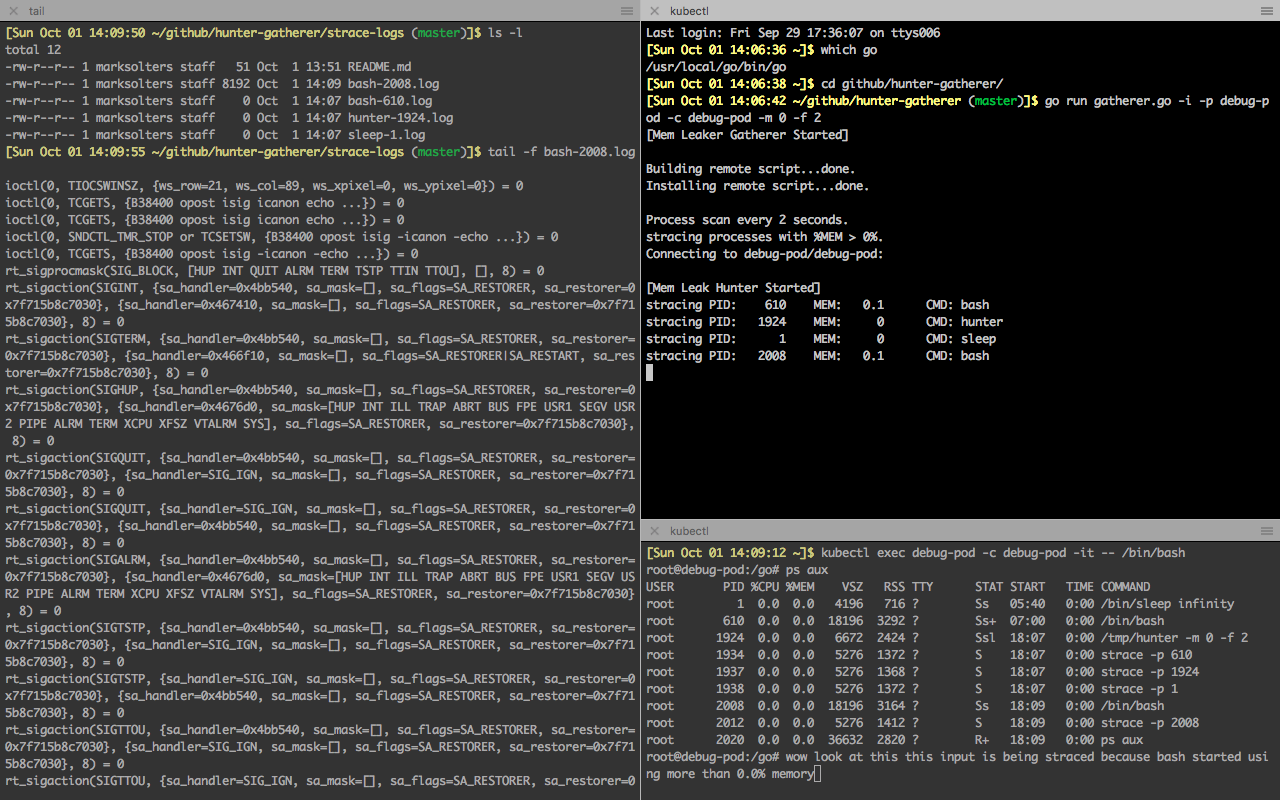strace debugging for memory leaks in Kubernetes containers and who wanna learn to debug other containers good, too.
You can pass this tool a Kube pod name, container name, and memory threshold, and it will create realtime strace log files on your local dev machine for all processes on the target container that are exceeding the memory threshold!
On your development machine:
gatherer -i -p problempod -c buggycontainer -m 50.0 -f 2Here's what will happen: Every 2 seconds, processes inside problempod/buggycontainer which are using more than 50.0% memory will be straced. The results will end up in strace-logs/<cmdname>-<pid>.log. You can tail these files as they're written.
In more detail, what happens is:
- The
hunterprogram will be built and copied to your target container - The
hunterprogram will begin polling for processes on the target container using, in this case, over50.0%memory every2seconds. stracewill be called on each offending process, and the data will be streamed back togathererrunning on your local machine- The incoming data will be redirected to local log files located in the
strace-logs/directory. Each file will have both the human-readable name of the command being logged as well as its PID.
You can CTRL-C out of gatherer to exit, which will sync local storage as well as (attempt to) close down hunter on the target container. This almost always works! However, sometimes kubectl can lag out or barf, in which case you may have to manually manage any zombie processes.
Local machine:
- Golang environment (you can run
hunterwithgo buildand execute, or justgo run) kubectl, authed for your target pods and containers.gathererwill usekubectltoexecandcpwith the target container.
Target machine:
topstrace(this can be tricky inside containers, see below)
| Arg | Description | Priority |
|---|---|---|
| -p | Name of target pod | required |
| -c | Name of target container | required |
| -i | Include this argument to copy hunter to target container |
optional, but must be run at least once, default false |
| -m | Memory usage threshold. Value interpreted as a percentage. Example values are like 50.0 or 12.3 etc. Processes on the target container exceeding this memory threshold will begin to be straced back to the gatherer app. |
optional, default 2.0 |
| -f | Scan frequency, in seconds. Whatever integer is provided here is how many seconds will pass between each scan of the running processes to determine if any are violating the memory threshold. | optional, default 5 |
Out-of-the-box hunter will assume the target container is a 64-bit Linux image. If this isn't the case, make sure to update GOOS and GOARCH inside build-hunter.sh!
By default, most Kube pods will not allow strace out-of-the-box. In fact, most common container images won't even have it installed.
But even with strace installed, you may find yourself getting error messages like this:
root@ubunt17-3503596890-f4m4v:/# strace -p 1
strace: attach: ptrace(PTRACE_ATTACH, ...): Operation not permitted
Could not attach to process. If your uid matches the uid of the target
process, check the setting of /proc/sys/kernel/yama/ptrace_scope, or try
again as the root user. For more details, see /etc/sysctl.d/10-ptrace.conf
What this means is that the container itself needs the SYS_ADMIN and SYS_PTRACE capabilities to be enabled for strace to function. If this was a simple local Docker container, we could just modify our Docker command:
docker run -t --pid=container:caddy \
--net=container:caddy \
--cap-add sys_admin \
--cap-add sys_ptrace \
strace(Above command taken from a great article by Justin Garrison)
To do this with Kubernetes, however, we need to modify our container capabilities by changing our .yaml definitions (see docs). Here's an example:
apiVersion: v1
kind: Pod
metadata:
name: debug-pod
spec:
containers:
- name: debug-pod
image: "golang:stretch"
command:
- /bin/sleep
- "infinity"
securityContext:
capabilities:
add: ["SYS_ADMIN", "SYS_PTRACE"]So if we create a pod like this, we can exec in, install strace, and start debugging no problem:
msolters@localhost:~/go/src/hunter-gatherer$ kubectl create -f strace-pod.yaml
pod "debug-pod" created
msolters@localhost:~/go/src/hunter-gatherer$ kubectl exec debug-pod -it -- /bin/bash
root@debug-pod:/go# apt-get update
Ign:1 http://deb.debian.org/debian stretch InRelease
Get:2 http://deb.debian.org/debian stretch-updates InRelease [91.0 kB]
Get:3 http://security.debian.org stretch/updates InRelease [62.9 kB]
Get:4 http://deb.debian.org/debian stretch Release [118 kB]
Get:5 http://deb.debian.org/debian stretch Release.gpg [2373 B]
Get:6 http://deb.debian.org/debian stretch-updates/main amd64 Packages [5553 B]
Get:7 http://security.debian.org stretch/updates/main amd64 Packages [215 kB]
Get:8 http://deb.debian.org/debian stretch/main amd64 Packages [9497 kB]
Fetched 9992 kB in 1s (5241 kB/s)
Reading package lists... Done
root@debug-pod:/go# apt-get install strace
Reading package lists... Done
Building dependency tree
Reading state information... Done
The following NEW packages will be installed:
strace
0 upgraded, 1 newly installed, 0 to remove and 8 not upgraded.
Need to get 533 kB of archives.
After this operation, 1396 kB of additional disk space will be used.
Get:1 http://deb.debian.org/debian stretch/main amd64 strace amd64 4.15-2 [533 kB]
Fetched 533 kB in 0s (3320 kB/s)
debconf: delaying package configuration, since apt-utils is not installed
Selecting previously unselected package strace.
(Reading database ... 15063 files and directories currently installed.)
Preparing to unpack .../strace_4.15-2_amd64.deb ...
Unpacking strace (4.15-2) ...
Setting up strace (4.15-2) ...
root@debug-pod:/go# strace -p 1
strace: Process 1 attached
restart_syscall(<... resuming interrupted nanosleep ...>If you're using strace to debug memory leaks in a Kube deployment that can't be inferred from other logs, you've clearly got issues my friend. It shouldn't be too much extra work to reconfigure your pods to be debuggable if it helps you track down the real problem!
boop
